Evaluation of a Coupled Model to Predict the Impact of Adaptive Behaviour in the Thermal Sensation of Occupants of Naturally Ventilated Buildings in Warm-Humid Regions
Abstract
:1. Introduction
2. Objectives
3. Methodology
3.1. Overall Setup and Quality Check for the CFD Simulations
3.2. The Thermal Sensation Model
− 0.42 [(M − W) − 58.15] − 1.7 × 10−5 M (5867 − pa) − 0.0014 M (34 − Tinside)
− 3.96 × 10−8 ƒcl [(tcl + 273)4 − (Tradmean + 274)4] − ƒcl hc (tcl − Tinside)}
3.3. Modelling the Virtual Ceiling Fan
3.4. The Scenarios for the Validation Exercise (Stage 1)
3.5. The Scenarios for the Application and Test of Adaptive Behaviour (Stage 2)
4. Results, Analysis, and Discussion
4.1. Results for the Validation Exercise (Stage 1)
4.2. Results for the Application and Test for Adaptive Behaviour (Stage 2)
4.3. Discussion about the Application of the Models to Adjust Thermal Sensation Indices
5. Conclusions
Author Contributions
Funding
Informed Consent Statement
Acknowledgments
Conflicts of Interest
References
- United Nations Department of Economic and Social Affairs Population Dynamics. Available online: https://population.un.org/wpp/ (accessed on 28 January 2019).
- UN. United Nations Population Division World Urbanization Prospects: The 2018 Re-Vision. 2018. Available online: https://population.un.org/wup/ (accessed on 9 May 2020).
- Beck, H.E.; Zimmermann, N.E.; McVicar, T.R.; Vergopolan, N.; Berg, A.; Wood, E.F. Present and future Köppen-Geiger climate classification maps at 1-km resolution. Sci. Data 2018, 5, 180214. [Google Scholar] [CrossRef] [PubMed] [Green Version]
- OECD/IEA. The Future of Cooling. Opportunities for Energy-Efficient Air Conditioning. Organisation for Economic Co-operation and Development. International Energy Agency. Available online: http://www.iea.org/publications/freepublication/The_Future_of_Cooling.pdf (accessed on 22 May 2018).
- WEF. Resuming Operations and Business Activity Post-COVID-19. Advanced Manufacturing Action Group. World Economic Forum-WEF Briefing Paper in Collaboration with McKinsey. Available online: http://www3.weforum.org/docs/WEF_Resuming_operations_and_business_activity_post_COVID19.pdf (accessed on 3 July 2020).
- Givoni, B. Climate Considerations in Building and Urban Design, 1st ed.; John Wiley & Sons: Hoboken, NJ, USA, 1998; ISBN -13 978-0471291770. [Google Scholar]
- Awbi, H.B. Ventilation of Buildings, 2nd ed.; Spon Press: London, UK, 2003; ISBN 9780419210801. [Google Scholar]
- ASHRAE. ASHRAE/ANSI Standard-55. Thermal Environmental Conditions for Human Occupancy; American Society of Heating and Air-Conditioning Engineers: Atlanta, GA, USA, 2017; ISSN 1041-2336. [Google Scholar]
- Fanger, P.O. Thermal Comfort; Danish Technical Press: Copenhagen, Denmark, 1970; ISBN 9780070199156. [Google Scholar]
- ISO 7726. Ergonomics of the Thermal Environment—Instruments for Measuring Physical Quantities; International Standard Organization: Geneva, Switzerland, 1998. [Google Scholar]
- ISO 7730. Ergonomics of the Thermal Environment—Analytical Determination and Interpretation of Thermal Comfort Using Calculation of the PMV and PPD Indices and Local Thermal Comfort Criteria; International Standard Organization: Geneva, Switzerland, 2005. [Google Scholar]
- prEN 15251 CEN/TC 156. Criteria for the Indoor Environment Including Thermal, Indoor Air Quality, Light, and Noise; Version 2.1c.; European Standard: Brussels, Belgium, 2005. [Google Scholar]
- De Dear, R.; Brager, G.S.; Cooper, D. Developing an Adaptive Model of Thermal Comfort and Preference. ASHRAE 1997. RP-884 Final Report. Available online: https://escholarship.org/uc/item/4qq2p9c6 (accessed on 18 September 2020).
- De Dear, R.J.; Brager, G.S. Thermal comfort in naturally ventilated buildings: Revisions to ASHRAE Standard 55. Energy Build. 2002, 34, 549–561. [Google Scholar] [CrossRef] [Green Version]
- Höppe, P. Different aspects of assessing indoor and outdoor thermal comfort. Energy Build. 2002, 34, 661–665. [Google Scholar] [CrossRef]
- Fiala, D. Physiological modeling for technical clinical and research applications. Front. Biosci. 2010, 2, 939–968. [Google Scholar] [CrossRef] [Green Version]
- Scheatzle, D.G.; Wu, H.; Yellott, J. Extending the summer comfort envelope with ceiling fans in hot arid climates. ASHRAE Trans. 1989, 95, 269–280. [Google Scholar]
- Mallick, F.H. Thermal comfort and building design in the tropical climates. Energy Build. 1996, 23, 161–167. [Google Scholar] [CrossRef]
- Indraganti, M. Behavioural adaptation and the use of environmental controls in summer for thermal comfort in apartments in India. Energy Build. 2010, 42, 1019–1025. [Google Scholar] [CrossRef]
- Fanger, P.O.; Toftum, J. Extension of the PMV model to non-air-conditioned buildings in warm climates. Energy Build. 2002, 34, 533–536. [Google Scholar] [CrossRef]
- Humphreys, M.A.; Nicol, J.F. The validity of ISO-PMV for predicting comfort votes in every-day thermal environments. Energy Build. 2002, 34, 667–684. [Google Scholar] [CrossRef]
- Professional Standard of the People’s Republic of China. Evaluation Standard for Indoor Thermal Environment in Civil Buildings; GB/T 50785-2012; China Building Industry Press: Beijing, China; Ministry of Housing and Urban-Rural Development: Beijing, China, 2012. [Google Scholar]
- Manu, S.; Shukla, Y.; Rawal, R.; Thomas, L.E.; De Dear, R. Field studies of thermal comfort across multiple climate zones for the subcontinent: India Model for Adaptive Comfort (IMAC). Build. Environ. 2016, 98, 55–70. [Google Scholar] [CrossRef] [Green Version]
- Tartarini, F.; Schiavon, S.; Cheung, T.; Hoyt, T. CBE Thermal Comfort Tool: Online tool for thermal comfort calculations and visualizations. SoftwareX 2020, 12, 100563. [Google Scholar] [CrossRef]
- Gagge, A.; Stolwijk, J.; Hardy, J. Comfort and thermal sensations and associated physiological responses at various ambient temperatures. Environ. Res. 1967, 1, 1–20. [Google Scholar] [CrossRef]
- Murakami, S.; Kato, S.; Zeng, J. Numerical thermoregulation-model JOS for evaluation of thermal comfort. In Proceedings of the Roomvent 2007: SANVAC, Helsinki, Finland, 13–15 June 2007. [Google Scholar]
- Huizenga, C.; Hui, Z.; Arens, E. A model of human physiology and comfort for assessing complex thermal environments. Build. Environ. 2001, 36, 691–699. [Google Scholar] [CrossRef] [Green Version]
- Völker, C.; Alsaad, H. Simulating the human body’s microclimate using automatic coupling of CFD and an advanced thermoregulation model. Indoor Air 2018, 28, 415–425. [Google Scholar] [CrossRef]
- Fiala, D. Dynamic Simulation of Human Heat Transfer and Thermal Comfort. Ph.D. Thesis, De Montfort University, Leicester, UK, 1998. [Google Scholar]
- Fiala, D.; Lomas, K.; Stohrer, M. Computer prediction of human thermoregulatory and temperature responses to a wide range of environmental conditions. Int. J. Biometeorol. 2001, 45, 143–159. [Google Scholar] [CrossRef]
- Fiala, D.; Lomas, K.; Stohrer, M. First Principles Modeling of Thermal Sensation Responses in Steady-State and Transient Conditions. ASHRAE Trans. 2003, 109, 179. [Google Scholar]
- Cropper, P.C.; Yang, T.; Cook, M.; Fiala, D.; Yousaf, R. Coupling a model of human thermoregulation with computational fluid dynamics for predicting human–environment interaction. J. Build. Perform. Simul. 2010, 3, 233–243. [Google Scholar] [CrossRef] [Green Version]
- Franke, J.; Hellsten, A.; Schlünzen, H.; Carissimo, B. Best Practice Guideline for the CFD Simulation of Flows in the Urban Environment. COST Action 732. Quality Assurance and Improvement of Microscale Meteorological Models; Meteorological Institute: Hamburg, Germany, 2007; ISBN 3-00-018312-4. [Google Scholar] [CrossRef]
- Celik, I.B.; Ghia, U.; Roache, P.J.; Freitas, C.J.; Coleman, H.; Raad, P.E. Procedure for Estimation and Reporting of Uncertainty Due to Discretization in CFD Applications. J. Fluids Eng. 2008, 130, 078001. [Google Scholar] [CrossRef] [Green Version]
- Lamberts, R.; Andreasi, W.A. Thermal Comfort in Buildings Located in Regions of Hot and Humid Climate of Brazil. Laboratory of Energy Efficiency in Buildings, LABEEE. UFSC. 2009. Available online: https://www.researchgate.net/publication/242253258_Thermal_comfort_in_buildings_located_in_regions_of_hot_and_humid_climate_of_Brazil/references (accessed on 10 May 2020).
- Andreasi, W.A.; Lamberts, R.; Candido, C. Thermal acceptability assessment in buildings located in hot and humid regions in Brazil. Build. Environ. 2010, 45, 1225–1232. [Google Scholar] [CrossRef]
- ANSYS ICEM CFD R16.0. ANSYS, Inc. Available online: www.ansys.com/ (accessed on 26 March 2018).
- ANSYS CFX R19.1. ANSYS, Inc. Available online: https://www.ansys.com/products/fluids/ansys-cfx (accessed on 26 March 2018).
- Versteeg, H.K.; Malalasekera, W. An Introduction to Computational Fluid Dynamics—The Finite Volume Model, 2nd ed.; Pearson: London, UK, 2007; ISBN 978-0-13-127498-3. [Google Scholar]
- ANSYS, Inc. Lecture 7: Mesh Quality & Advanced Topics. Introduction to ANSYS Meshing. 15.0 Release. 2015. Available online: www.ansys.com/ (accessed on 20 June 2020).
- ANSYS, Inc. Lecture 5: Prism Meshing. Introduction to ANSYS ICEM CFD. 14.0 Release. 2012. Available online: www.ansys.com/ (accessed on 20 June 2020).
- Streblow, R. Thermal Sensation and Comfort Model for Inhomogeneous Indoor Environments. Ph.D. Thesis, Aachen University, Aachen, Germany, 28 May 2010. [Google Scholar]
- Peren, J.I.; Van Hooff, T.; Leite, B.; Blocken, B. CFD simulation of wind-driven upward cross ventilation and its enhancement in long buildings: Impact of single-span versus double-span leeward sawtooth roof and opening ratio. Build. Environ. 2016, 96, 142–156. [Google Scholar] [CrossRef] [Green Version]
- Babich, F.; Cook, M.; Loveday, D.; Cropper, P. Numerical Modelling of Thermal Comfort in Non-Uniform Environments Using Real-time Coupled Simulation Models. Proc. Build. Simul. Optim. 2016, 4–11. Available online: https://hdl.handle.net/2134/22632 (accessed on 2 November 2019).
- Babich, F.; Cook, M.J.; Loveday, D.; Rawal, R.; Shukla, Y. Transient three-dimensional CFD modelling of ceiling fans. Build. Environ. 2017, 123, 37–49. [Google Scholar] [CrossRef] [Green Version]
- Sabatino, R. A Coupled CFD and Thermoregulation Model to Evaluate Thermal Comfort Criteria in Asymmetrical Thermal Environments Created by Ceiling Fan Heating Systems. Ph.D. Thesis, Università degli Studi di Salerno, Fisciano, Italy, 2018. [Google Scholar]
- Hajdukiewicz, M.; Geron, M.; Keane, M.M. Formal calibration methodology for CFD models of naturally ventilated indoor environments. Build. Environ. 2013, 59, 290–302. [Google Scholar] [CrossRef] [Green Version]
- Roache, P.J. Quantification of Uncertainty in Computational Fluid Dynamics. Annu. Rev. Fluid Mech. 1997, 29, 123–160. [Google Scholar] [CrossRef] [Green Version]
- Havenith, G.; Heus, R.; Lotens, W.A. Resultant clothing insulation: A function of body movement, posture, wind, clothing fit and ensemble thickness. Ergonomics 1990, 33, 67–84. [Google Scholar] [CrossRef]
- Procel. Ventiladores de Teto.Selo Procel: Programa Nacional de Conservação de Energia Elétrica. Centro Brasileiro de Informação de Eficiência Energética. Eletrobrás. 6 August 2019. Available online: http://www.procelinfo.com.br/ (accessed on 22 October 2019).
- Santamouris, M. Ventilation for Comfort and Cooling: The State of the Art. In Building Ventilation: The State-of-the-Art; Santamouris, M., Wouters, P., Eds.; Earthscan: London, UK, 2007; pp. 217–246. [Google Scholar] [CrossRef]
- Chandra, S.; Fairey, P.; Houston, M. Cooling with Ventilation. A Product of the Solar Technical Information Program; Solar Energy Research Institute, Department of Energy: Cocoa, FL, USA, 1986. [Google Scholar]
- ISO 10551. Ergonomics of the Thermal Environment—Assessment of the Influence of the Thermal Environment Using Subjective Judgement Scales; International Standard Organization: Geneva, Switzerland, 1995. [Google Scholar]
- Naghshpour, S. Statistics for Economics. Business Expert Press: New York, NY, USA, 2012; p. 475. [Google Scholar]
- Croft, A.; Davison, R. Foundation Maths, 5th ed.; Pearson: Harlow, UK, 2010. [Google Scholar]
- ASHRAE. ASHRAE/ANSI Guideline 14. Measurement of Energy Demand and Savings; American Society of Heating and Air-Conditioning Engineers: Atlanta, GA, USA, 2002. [Google Scholar]
- US Department of Energy. International Performance Measurement & Verification Protocol—IPMVP. Concepts and Options for Determining Energy and Water Savings; International Performance Measurement & Verification Protocol Committee: Washington, DC, USA; US Department of Energy: Washington, DC, USA, 2002; Volume I, p. 92, DOE/GO-102002-1554.
- Koop, L.K.; Tadi, P. Physiology, Heat Loss (Convection, Evaporation, Radiation); StatPearls: Treasure Island, FL, USA, 2020. Available online: https://www.ncbi.nlm.nih.gov/books/NBK541107/ (accessed on 20 October 2020).
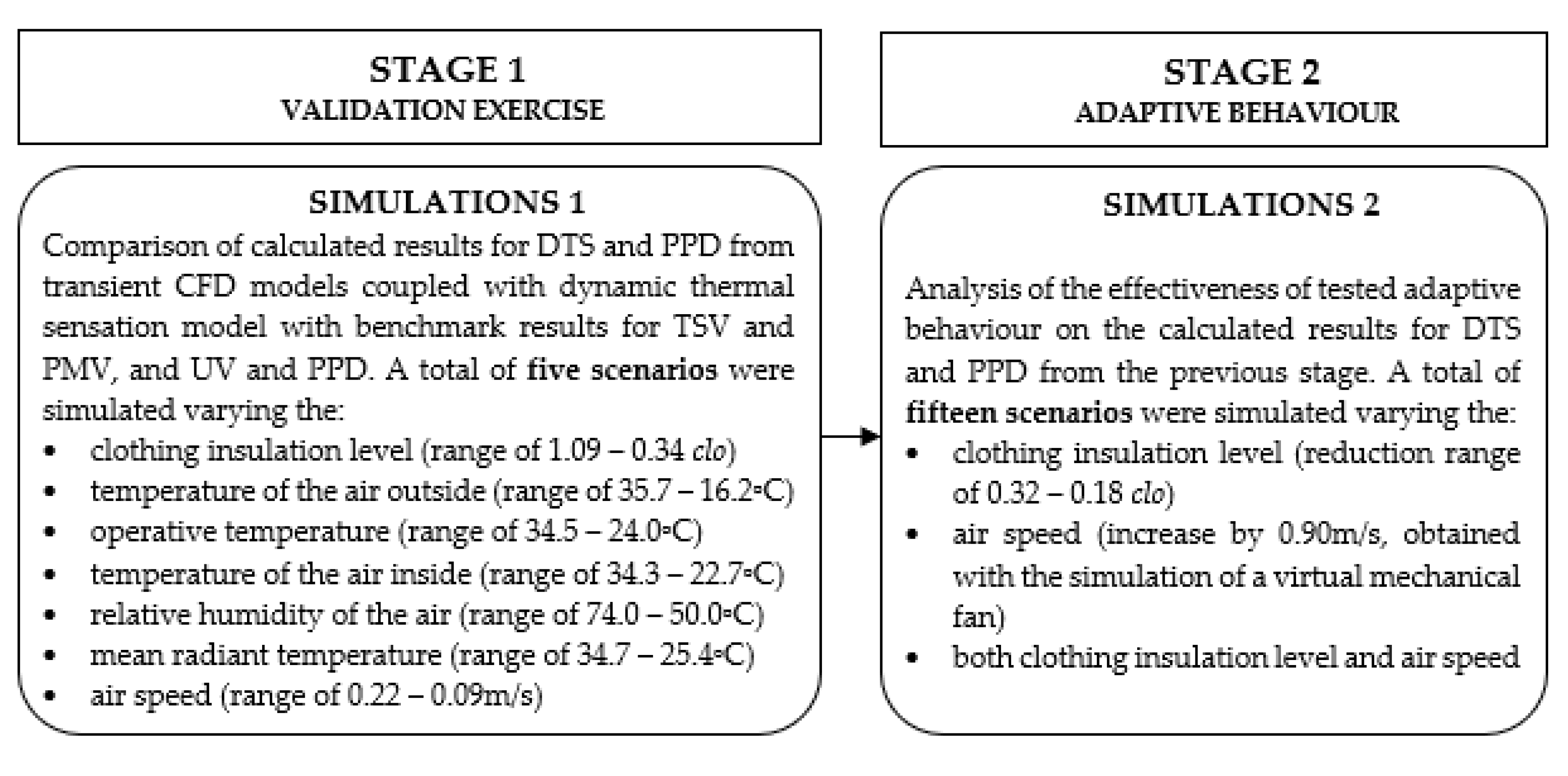

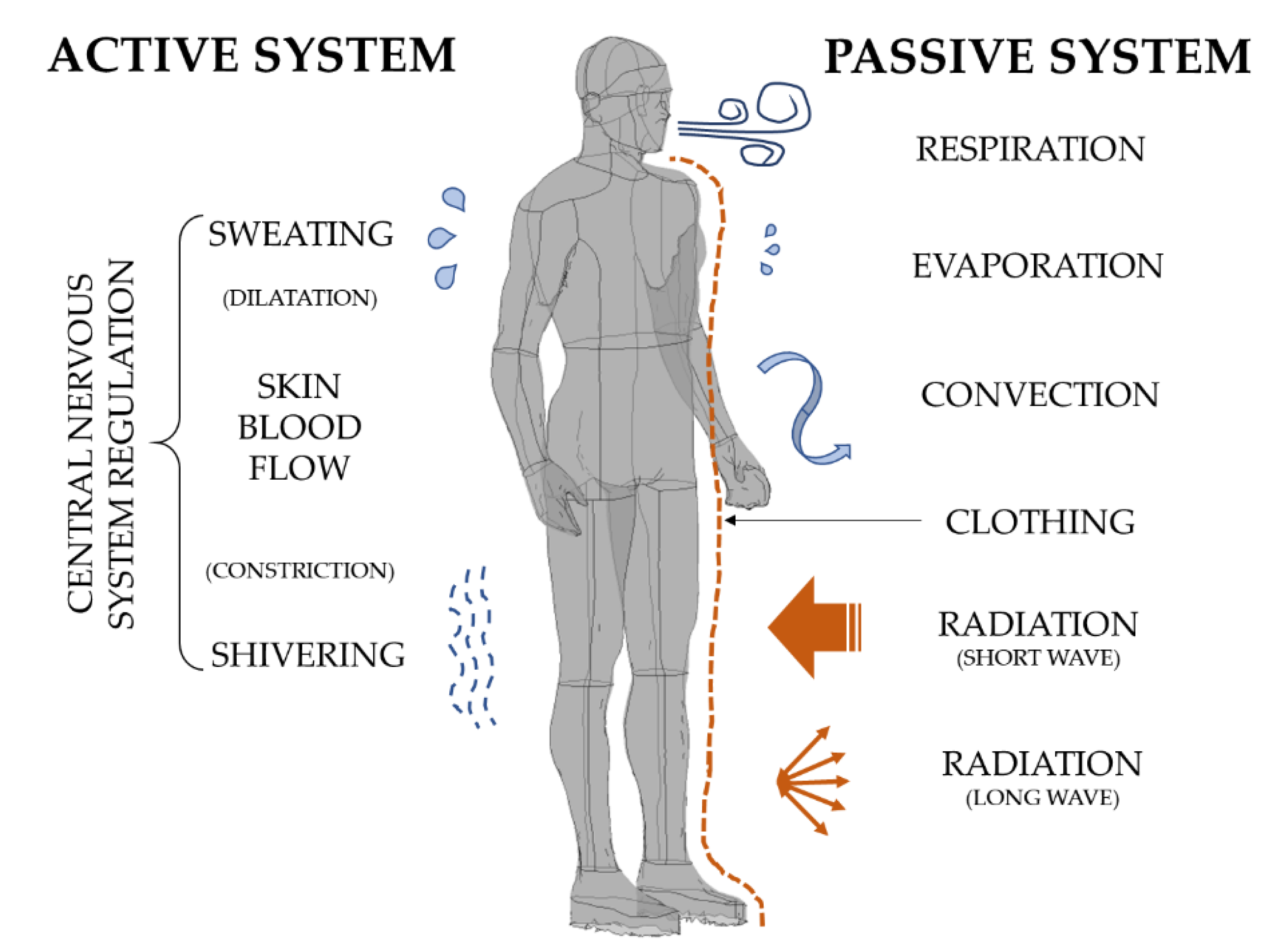

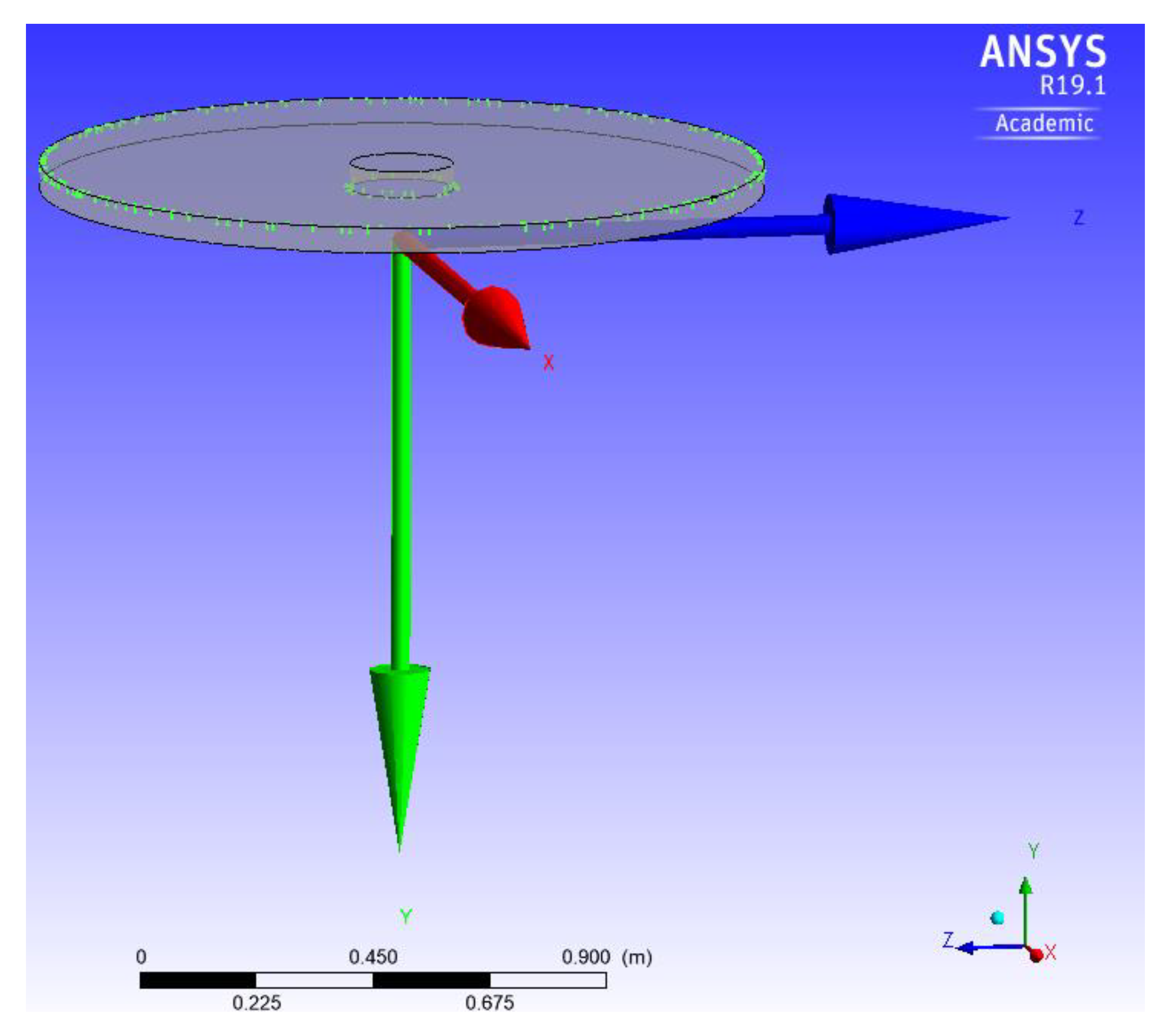
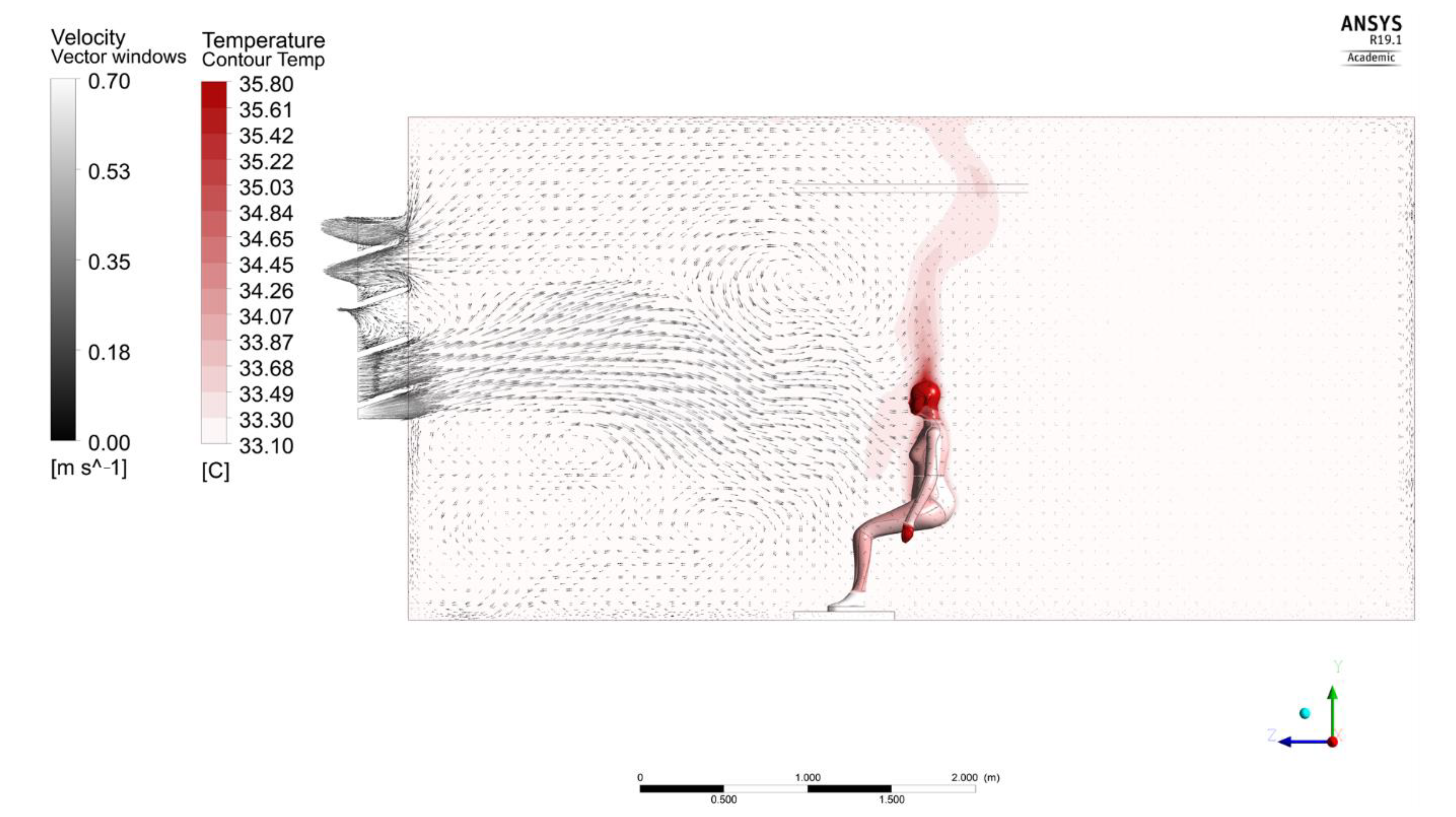

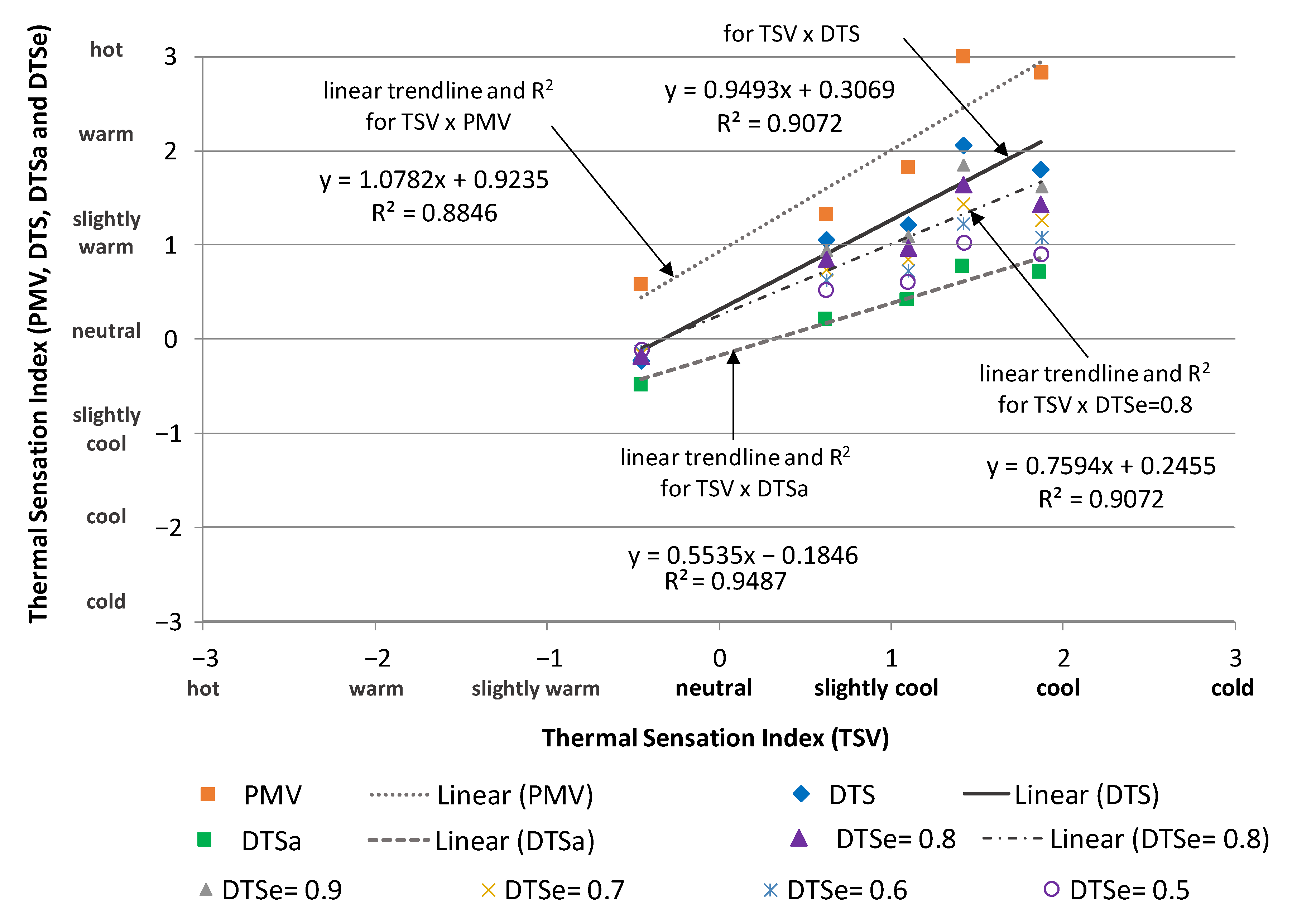
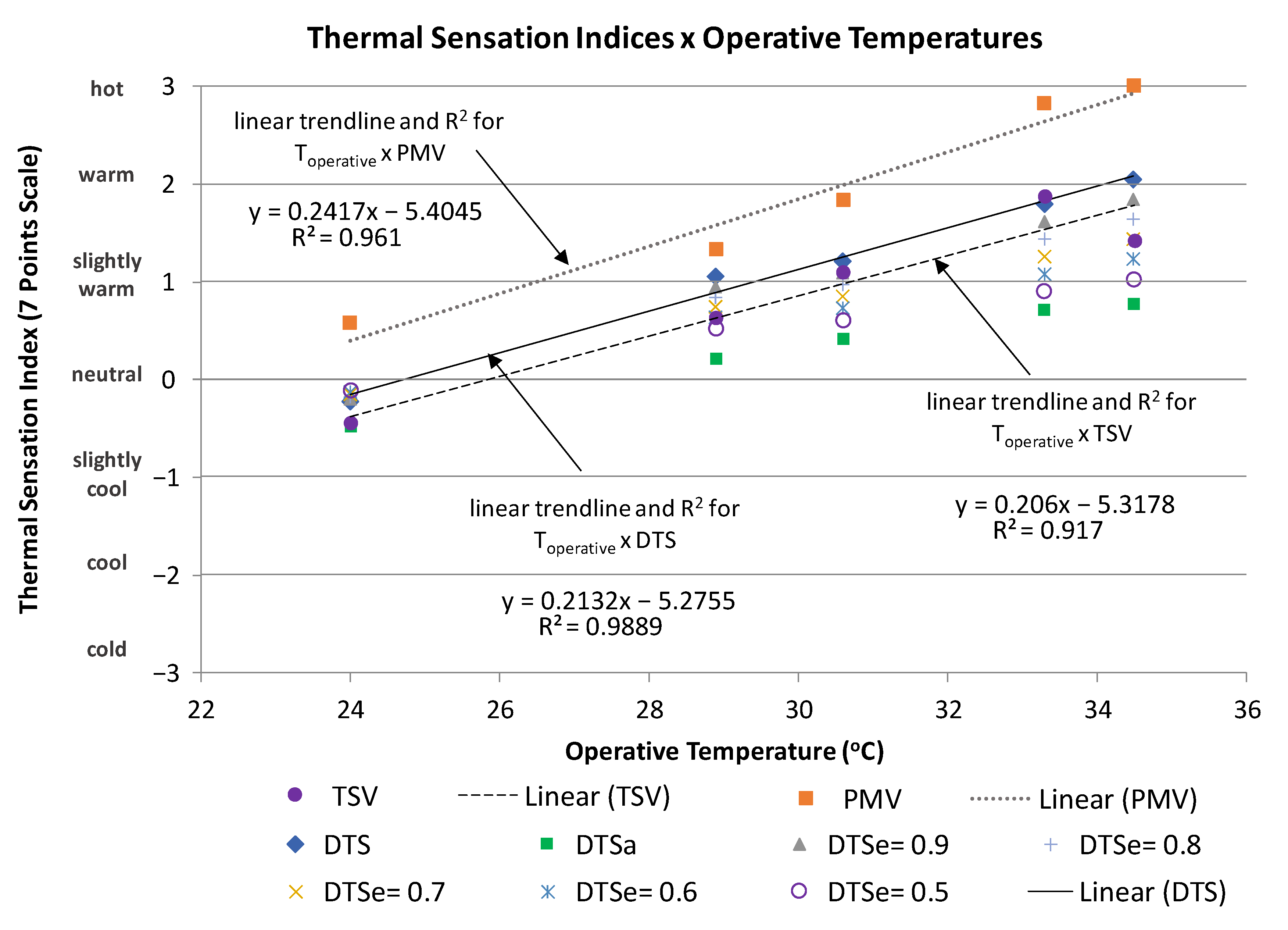
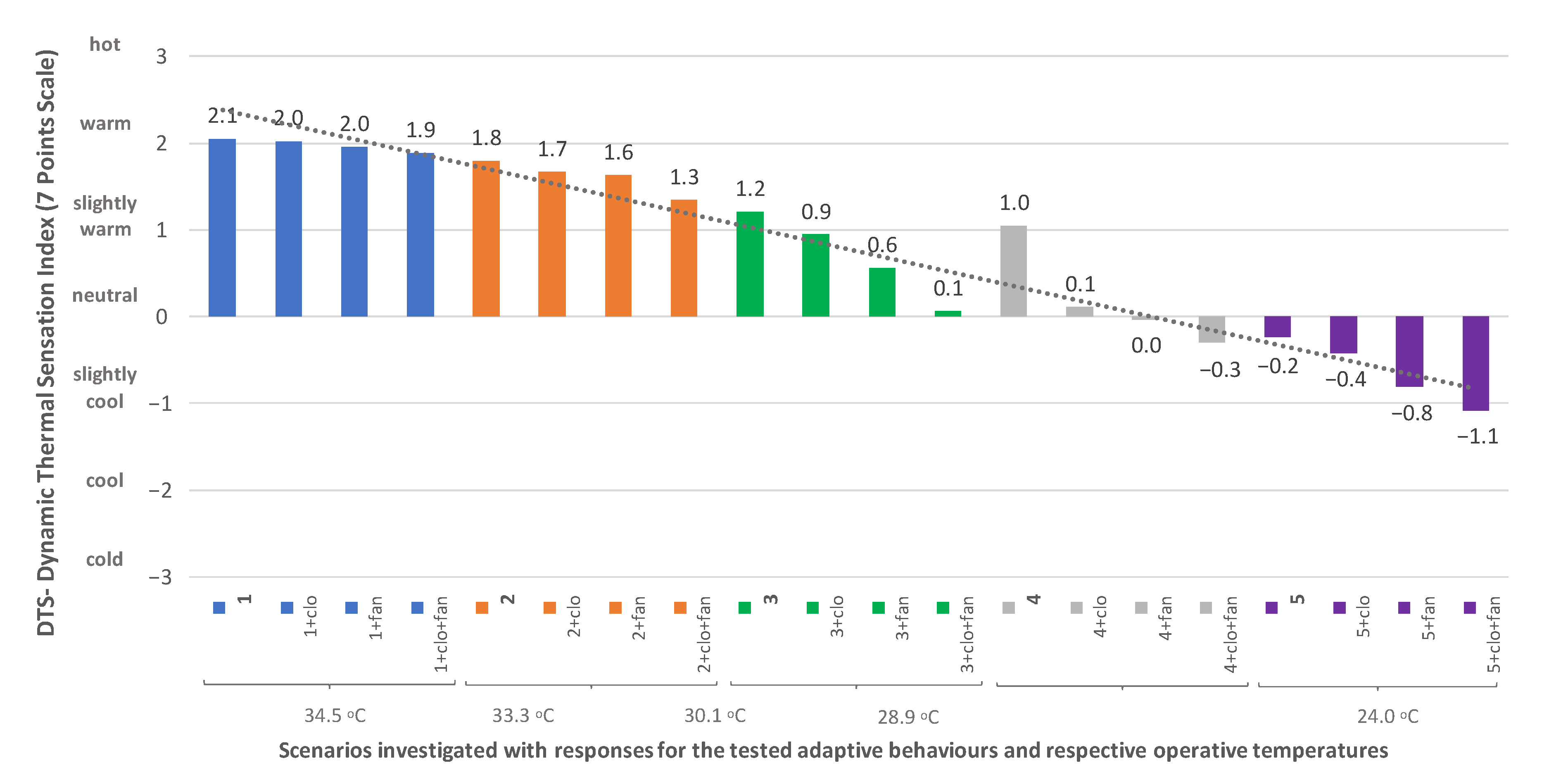

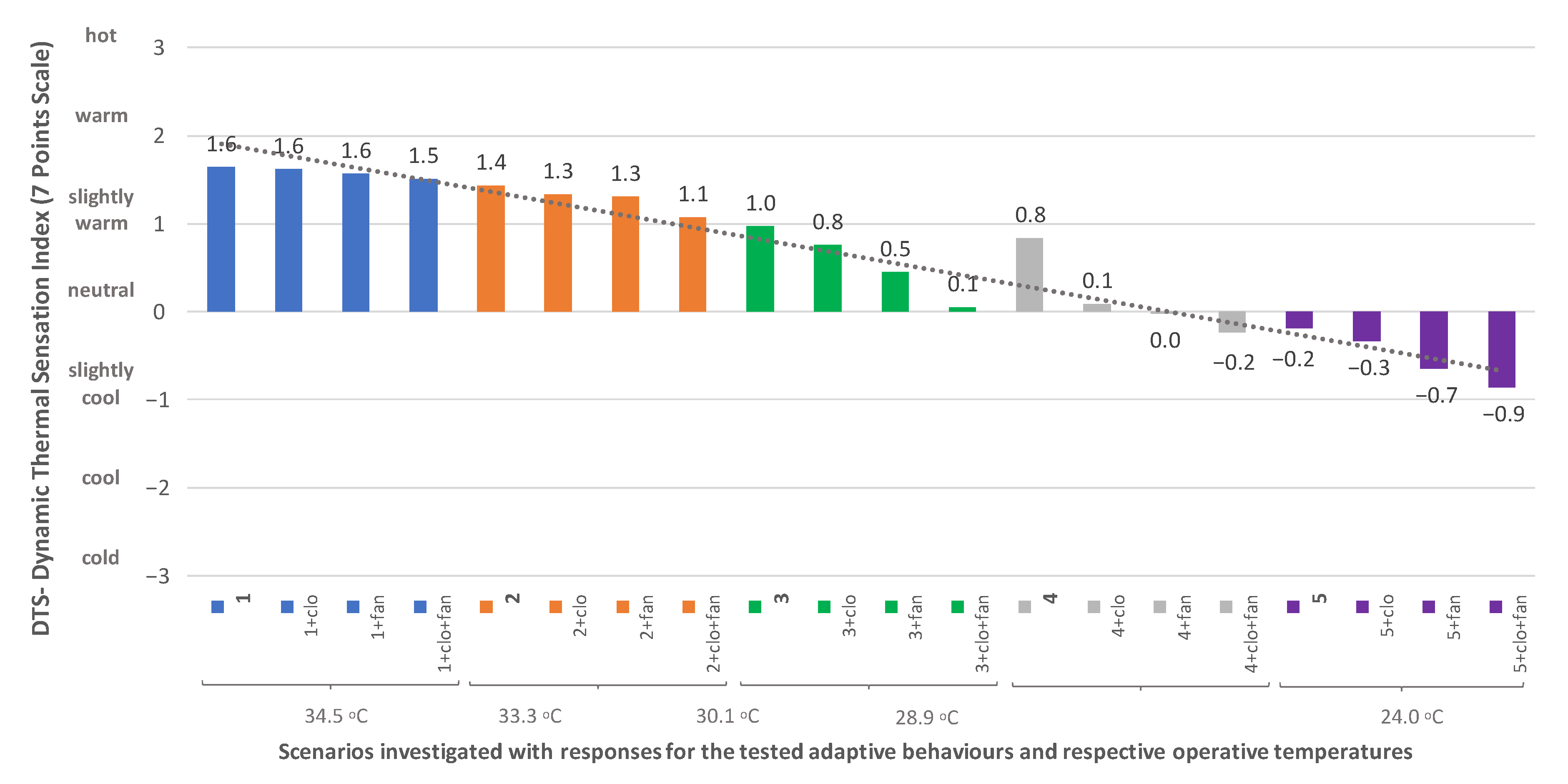
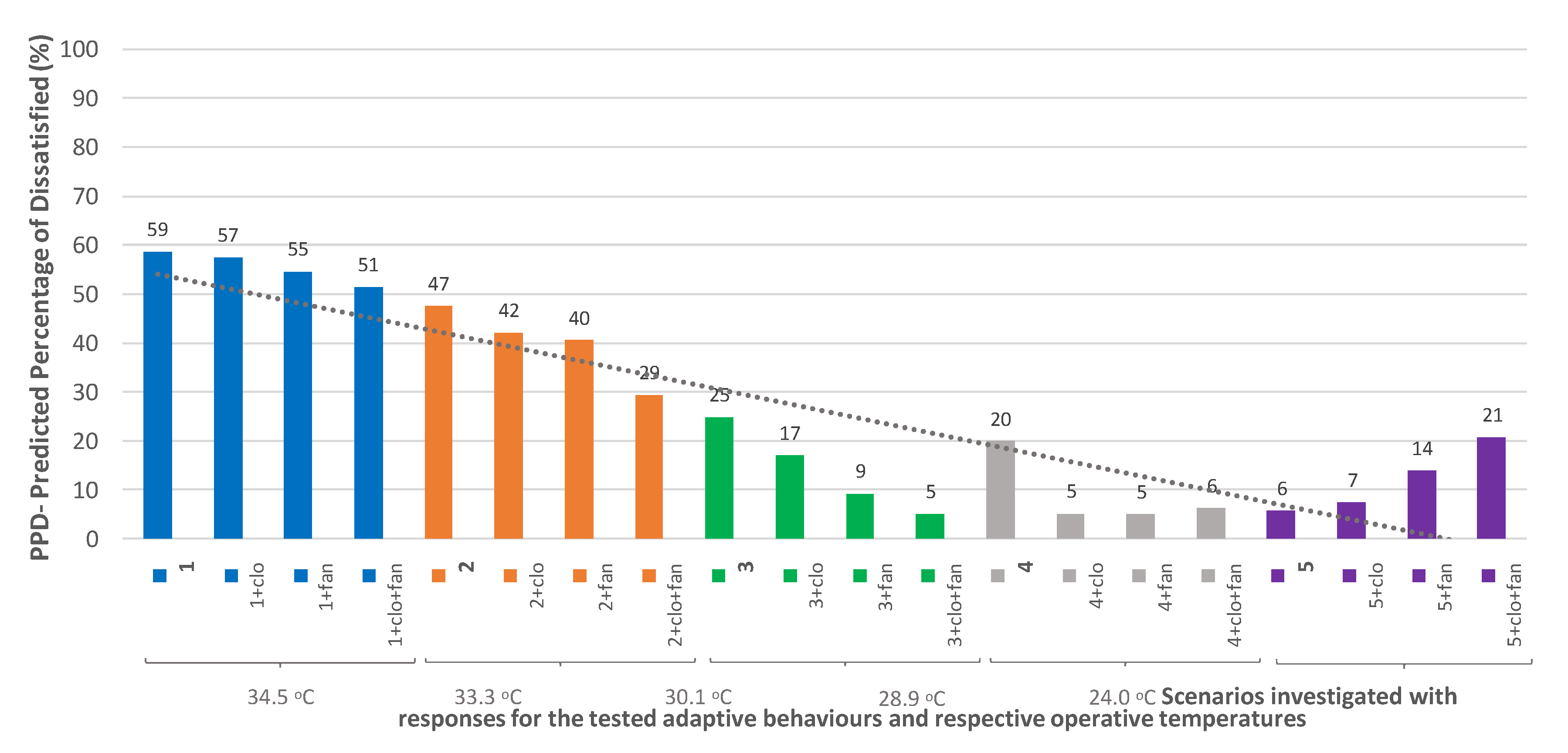
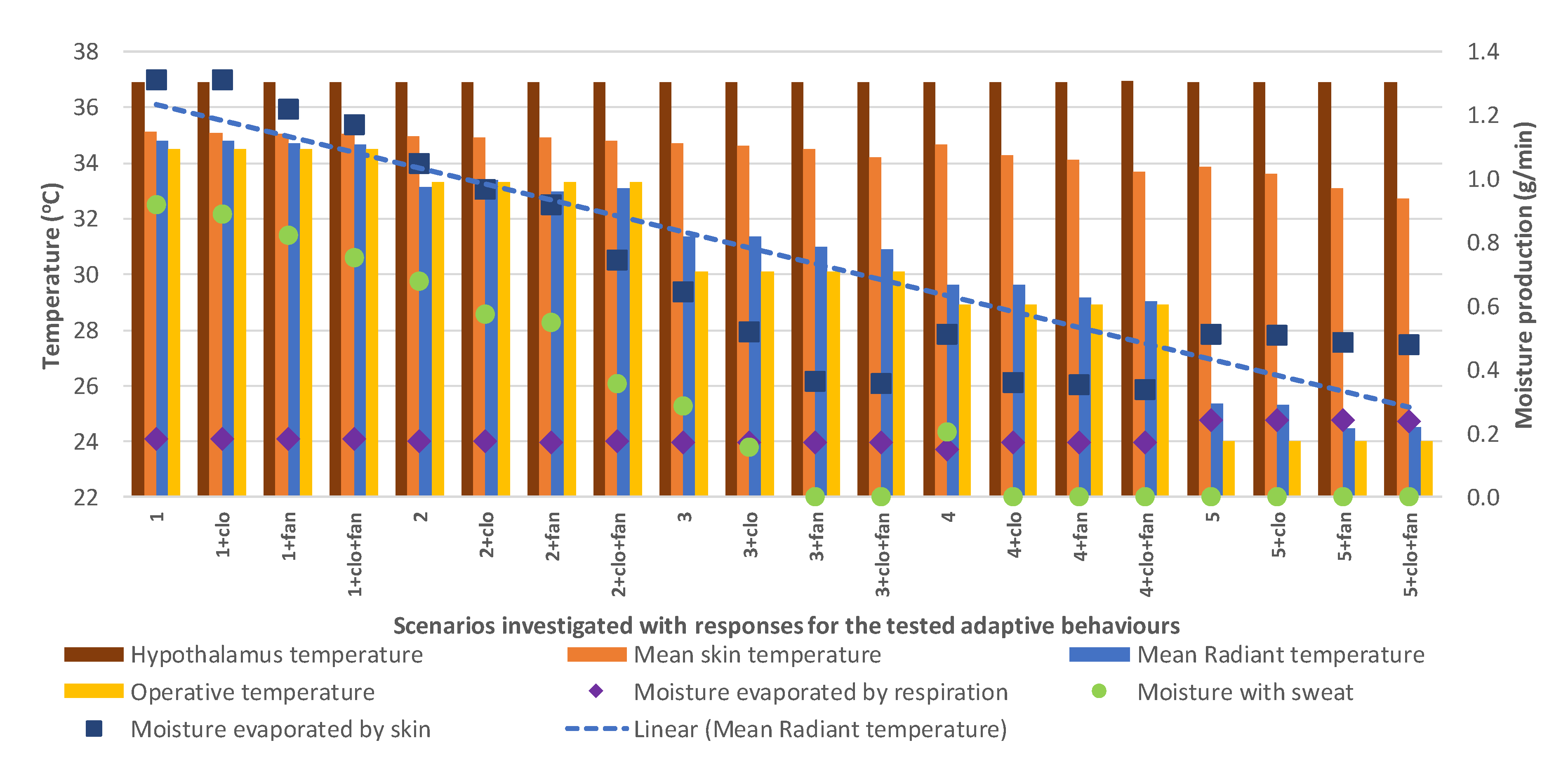
| Grid Parameters and Averaged Results: | Grid 1 | Grid 2 | Grid 3 |
|---|---|---|---|
| Number of elements | 3,051,645 | 6,293,498 | 7,496,958 |
| Number of nodes | 895,592 | 2,066,548 | 2,584,876 |
| Air temperature (°C) | 34.53 | 34.47 | 34.45 |
| Air velocity (m/s) | 0.91 | 0.85 | 0.83 |
| Mean skin temperature (°C) | 35.73 | 35.75 | 35.79 |
| Parameters of Analysis for: | Grid 2- Grid 1 | Grid 3- Grid 2 |
|---|---|---|
| Grid refinement factor (ry-x) based on: | R grid 2- grid 1 | R grid 3- grid 2 |
| Number of cells | 1.27 | 1.07 |
| Number of nodes | 1.32 | 1.09 |
| Percentual approximated relative errors (eayx) for: | ea21 | ea32 |
| Air temperature | 0.16% | 0.07% |
| Air velocity | 5.96% | 3.34% |
| Mean skin temperature | −0.07% | −0.11% |
| Fine grid convergence index (GCIfineyx)for averaged results for key variables: | GCIfinegrid 2-grid 1 | GCIfine grid 3-grid 2 |
| Air temperature | 0.22% | 0.04% |
| Air velocity | 8.21% | 2.06% |
| Mean skin temperature | −0.09% | −0.07% |
| Averaged results | 1.67% | 0.41% |
| Mesh Quality Parameters: | Mean Results for Grid 2 | % of High-Quality Elements (Q1) | Quality Criteria |
|---|---|---|---|
| Overall quality | 0.78 | 68% | From 0.0 (worst) to 1.00 (perfect) |
| Orthogonal quality | 0.87 | 82% | From 0.0 (worst) to 1.00 (perfect) |
| Minimum orthogonality angle | 6.90° | 98% | Values should be lower than 60° |
| Equiangle skewness | 0.73 | 60% | From 0.0 (worst) to 1.00 (perfect) |
| Aspect ratio for 3D models | 4.07 | 83% | Values lower than 100 |
| Smoothness | 0.78 | 67% | Good < 1.5; fair 1.5 ≤ 2.5, and poor > 2.5 |
| Maximum expansion factor | 1.00 | 95% | From 1.0 (perfect) to 100.0 (worst) |
| Scenario | Metabolic | Clothing | Parameters for the Environment Conditions | ||||||
|---|---|---|---|---|---|---|---|---|---|
| Ratio | Insulation | Tair outside | Toperative | Tair inside | Tradmean | RH | Vair | Garment | |
| (met) | (clo) | (°C) | (°C) | (°C) | (°C) | (%) | (m/s) | Ensemble * | |
| 1 | 1.2 | 0.34 | 35.7 | 34.5 | 34.3 | 34.7 | 50 | 0.22 | casual |
| 2 | 1.2 | 0.34 | 34.0 | 33.3 | 33.6 | 33.0 | 55 | 0.15 | casual |
| 3 | 1.2 | 0.50 | 29.0 | 30.6 | 30.1 | 31.1 | 68 | 0.18 | casual |
| 4 | 1.2 | 0.59 | 30.7 | 28.9 | 28.5 | 29.3 | 74 | 0.19 | thin sweater |
| 5 | 1.2 | 1.09 | 16.2 | 24.0 | 22.7 | 25.4 | 59 | 0.09 | thick sweater |
| Scenario | Metabolic Ratio (met) | Clothing Insulation (clo) | Parameters for the Environment Conditions | ||||||
|---|---|---|---|---|---|---|---|---|---|
| Tair outside (°C) | Toperative (°C) | Tair inside (°C) | Tradmean (°C) | RH (%) | Vair (m/s) | Garment Ensemble * | |||
| 1 + clo | 1.20 | 0.34 | 35.7 | 34.5 | 34.3 | 34.7 | 50 | 0.22 | summer |
| 2 + clo | 1.20 | 0.34 | 34.0 | 33.3 | 33.6 | 33.0 | 55 | 0.15 | summer |
| 3 + clo | 1.20 | 0.50 | 29.0 | 30.6 | 30.1 | 31.1 | 68 | 0.18 | summer |
| 4 + clo | 1.20 | 0.59 | 30.7 | 28.9 | 28.5 | 29.3 | 74 | 0.19 | casual |
| 5 + clo | 1.20 | 1.09 | 16.2 | 24.0 | 22.7 | 25.4 | 59 | 0.09 | thin sweater |
| 1 + fan | 1.20 | 0.34 | 35.7 | 34.5 | 34.3 | 34.7 | 50 | 0.90 | casual |
| 2 + fan | 1.20 | 0.34 | 34.0 | 33.3 | 33.6 | 33.0 | 55 | 0.90 | casual |
| 3 + fan | 1.20 | 0.50 | 29.0 | 30.6 | 30.1 | 31.1 | 68 | 0.90 | casual |
| 4 + fan | 1.20 | 0.59 | 30.7 | 28.9 | 28.5 | 29.3 | 74 | 0.90 | thin sweater |
| 5 + fan | 1.20 | 1.09 | 16.2 | 24.0 | 22.7 | 25.4 | 59 | 0.90 | thick sweater |
| 1 + clo + fan | 1.20 | 0.34 | 35.7 | 34.5 | 34.3 | 34.7 | 50 | 0.90 | summer |
| 2 + clo + fan | 1.20 | 0.34 | 34.0 | 33.3 | 33.6 | 33.0 | 55 | 0.90 | summer |
| 3 + clo + fan | 1.20 | 0.50 | 29.0 | 30.6 | 30.1 | 31.1 | 68 | 0.90 | summer |
| 4 + clo + fan | 1.20 | 0.59 | 30.7 | 28.9 | 28.5 | 29.3 | 74 | 0.90 | casual |
| 5 + clo + fan | 1.20 | 1.09 | 16.2 | 24.0 | 22.7 | 25.4 | 59 | 0.90 | thin sweater |
| Scenario | Measured Values [35,36] | Calculated Results (CFD) | ||||
|---|---|---|---|---|---|---|
| Toperative (°C) | Vair (m/s) | Clothing (clo) | Toperative (°C) | Vair (m/s) | Clothing (clo) | |
| 1 | 34.5 | 0.22 | 0.34 | 34.5 | 0.09 | 0.46 |
| 2 | 33.3 | 0.15 | 0.34 | 33.3 | 0.12 | 0.46 |
| 3 | 30.6 | 0.18 | 0.50 | 30.1 | 0.04 | 0.46 |
| 4 | 28.9 | 0.19 | 0.59 | 28.6 | 0.18 | 0.64 |
| 5 | 24.0 | 0.09 | 1.09 | 23.4 | 0.13 | 0.96 |
| Scenarios | Benchmark Values [35,36] | Calculated Results (CFD) | |||||||
|---|---|---|---|---|---|---|---|---|---|
| DTS | DTSa | DTSe | DTSe | DTSe | DTSe | DTSe | |||
| TSV | PMV | e = 0.9 | e = 0.8 | e = 0.7 | e = 0.6 | e = 0.5 | |||
| 1 | 1.4 | 3.0 | 2.1 | 0.8 | 1.8 | 1.6 | 1.4 | 1.2 | 1.0 |
| 2 | 1.9 | 2.8 | 1.8 | 0.7 | 1.6 | 1.4 | 1.3 | 1.1 | 0.9 |
| 3 | 1.1 | 1.8 | 1.2 | 0.4 | 1.1 | 1.0 | 0.8 | 0.7 | 0.6 |
| 4 | 0.6 | 1.3 | 1.0 | 0.2 | 0.9 | 0.8 | 0.7 | 0.6 | 0.5 |
| 5 | −0.5 | 0.6 | −0.2 | −0.5 | −0.2 | −0.2 | −0.2 | −0.1 | −0.1 |
| Statistical Criteria: | Calculated Results | Calibration Criteria [56,57] | |||||||
|---|---|---|---|---|---|---|---|---|---|
| PMV [35,36] | DTS | DTSa | DTSe | DTSe | DTSe | DTSe | DTSe | ||
| e = 0.9 | e = 0.8 | e = 0.7 | e = 0.6 | e = 0.5 | |||||
| Standard deviation | 0.99 | 0.80 | 0.71 | 0.76 | 0.72 | 0.69 | 0.66 | 0.65 | same unit of variable |
| Correlation coefficient | 0.94 | 0.95 | 0.97 | 0.95 | 0.95 | 0.95 | 0.95 | 0.95 | 0.0 (weak) to 1.0 (strong) |
| Coefficient of determination | 0.88 | 0.91 | 0.95 | 0.91 | 0.91 | 0.91 | 0.91 | 0.91 | ≥0.75 |
| Root mean square error | 1.04 | 0.36 | 0.70 | 0.28 | 0.27 | 0.33 | 0.43 | 0.54 | same unit of variable |
| RMSE coefficient of variation | 272% | 71% | 162% | 39% | 7% | 25% | 57% | 89% | <30% |
| Mean bias error | 100% | 26% | 59% | 14% | 3% | 9% | 21% | 33% | ±20% |
| Normalized mean bias error | 109% | 28% | 65% | 16% | 3% | 10% | 23% | 36% | ±10% |
| Goodness-of-fit | 2.07 | 0.54 | 1.23 | 0.30 | 0.05 | 0.19 | 0.44 | 0.68 | low value = low dispersion |
Publisher’s Note: MDPI stays neutral with regard to jurisdictional claims in published maps and institutional affiliations. |
© 2020 by the authors. Licensee MDPI, Basel, Switzerland. This article is an open access article distributed under the terms and conditions of the Creative Commons Attribution (CC BY) license (http://creativecommons.org/licenses/by/4.0/).
Share and Cite
de Faria, L.C.; Romero, M.A.; Pirró, L.F.S. Evaluation of a Coupled Model to Predict the Impact of Adaptive Behaviour in the Thermal Sensation of Occupants of Naturally Ventilated Buildings in Warm-Humid Regions. Sustainability 2021, 13, 255. https://doi.org/10.3390/su13010255
de Faria LC, Romero MA, Pirró LFS. Evaluation of a Coupled Model to Predict the Impact of Adaptive Behaviour in the Thermal Sensation of Occupants of Naturally Ventilated Buildings in Warm-Humid Regions. Sustainability. 2021; 13(1):255. https://doi.org/10.3390/su13010255
Chicago/Turabian Stylede Faria, Luciano C., Marcelo A. Romero, and Lúcia F. S. Pirró. 2021. "Evaluation of a Coupled Model to Predict the Impact of Adaptive Behaviour in the Thermal Sensation of Occupants of Naturally Ventilated Buildings in Warm-Humid Regions" Sustainability 13, no. 1: 255. https://doi.org/10.3390/su13010255
APA Stylede Faria, L. C., Romero, M. A., & Pirró, L. F. S. (2021). Evaluation of a Coupled Model to Predict the Impact of Adaptive Behaviour in the Thermal Sensation of Occupants of Naturally Ventilated Buildings in Warm-Humid Regions. Sustainability, 13(1), 255. https://doi.org/10.3390/su13010255





